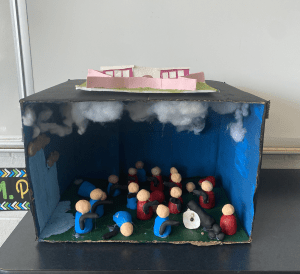
Battle of Lundy’s Lane and the Siege of Fort Erie


In Jewish Studies class, we were asked to make a “playlist”. This is really us just finding three verses from Pirkei Avot chapter two and finding a song that connects to each one.
1.
Pirkei Avot 2:6
“Moreover he saw a skull floating on the face of the water. He said to it: because you drowned others, they drowned you. And in the end, they that drowned you will be drowned”(Avot 2:6) . This verse means that if you do something bad, the same thing will happen to you or worse. This teaches you to be mindful of your actions. You need to stop and think about your actions and the consequences that will follow. Would you like someone to do the same thing to you?
I think that the song “What Goes Around… Comes Around” by Justin Timberlake can relate to this verse because it focuses on the concept of karma. The chorus of this song states, “What goes around, goes around, goes around Comes all the way back around” (Timberlake). The meaning of this quote is that what you do will come back to haunt you. The connection between the song and the verse is clear. We must avoid these negative actions because they will ultimately come back.
______________________________________________________________________________________
2.
Pirkei Avot 2:3
Be careful [in your dealings] with the ruling authorities for they do not befriend a person except for their own needs; they seem like friends when it is to their own interest, but they do not stand by a man in the hour of his distress (Avot 2:3). This verse means that if you put your trust in people who act as if they care for you but they are really just faking it will end up hurting you (not them). This teaches you to be mindful of your decisions of who you become friends with and get to know them before you put all your trust in them.
I think the song “Since U Been Gone” by Kelly Clarkson can relate to this verse because it focuses on the concept of a person must figure out the intentions of another individual before they trust them. In this song, it says, “Here’s the thing, we started out friends
It was cool, but it was all pretend”. The meaning of this quote is they were friends and she trusted him but then she figured out that it “was all pretend” (Clarkson). The connection between the song and the verse is clear. They are both talking about fake friends and you have to be careful because it can end up really hurting you.
______________________________________________________________________________________
Pirkei Avot 2:2
Rabban Gamaliel the son of Rabbi Judah Hanasi said: excellent is the study of the torah when combined with a worldly occupation, for toil in them both keeps sin out of one’s mind; But [study of the] Torah which is not combined with a worldly occupation, in the end comes to be neglected and becomes the cause of sin. And all who labour with the community should labour with them for the sake Heaven, for the merit of their forefathers sustains them (the, and their (the forefather’ righteousness endures forever; And as for you, [God in such case says] I credit you with a rich reward, as if you [yourselves] had [actually] accomplished [it all] (Avot 2:2).
This verse means If you respect and follow the teaching of the Torah, sin won’t be on your mind. You need to make time to focus on Torah study. If you simply study the Torah, without actually following the lessons and teachings, you will sin. If you do something good, it will not only help yourself, but others in your community. These good deeds will also honour your ancestors.This teaches you that respecting the Torah is important. However, studying and respecting the Torah isn’t enough. You must learn the right way to live your life and follow through on your actions.
I think the song “Truth” by Lucinda Williams can relate to this verse because it focuses on the concept of you being in charge of following through with your decisions. This quote from the song states, “God put the firewood there, but you gotta light yourself” (Williams). This song connects to this verse as it focuses on a person needing to take action. Williams teaches us that the foundation of a project might be provided for you, but the project will not be complete until you take the initiative to do it yourself. Similarly, the verse from Pirkei Avot says that God put the Torah there, but you are in charge of following through and doing the mitzvot you learned.